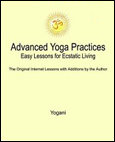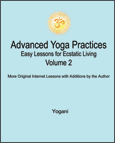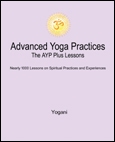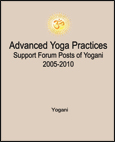|
Public Home | Plus Home | Main Lessons | Tantra Lessons | Public Forum | Plus Forum | Downloads | Books Topic Paths | Search | Training-Retreats | Testimonials | Survey | Interviews | MultiMedia | Contact | Donate |
|
Advanced Yoga Practices Note: For the Original Internet Lessons with additions, see the AYP Easy Lessons Books. For the Expanded and Interactive Internet Lessons, AYP Online Books, Audiobooks and more, see AYP Plus. Lesson 58 - Step by Step (Audio)
From: Yogani New Visitors: It is recommended you read from the beginning of the archive, as previous lessons are prerequisite to this one. The first lesson is, "Why This Discussion?" Q: My question relates to the effects of combining the methods recommended by you with the ones that I am formerly accustomed to. Will they enhance each other or will they be counterproductive? Relating to the most recent addition - Sambhavi - all I can say is Whoa! You could most definitely say I'm going through that "clunky" stage! The ability to hold anal sphincter tone, contract abs, breathe with a hiss on exhalation, cross your eyes to reach the third eye ... all simultaneously ... is really quite a task, much less to try to do it in a relaxed mode. A: Of course, whatever you practice is your choice. If you are following an established teaching, there is no wish here to interfere with that. In that case, just consider these lessons to be "food for thought." If you are trying to piece things together yourself, then some definite advice is offered. First, less is more in spiritual practice. Simplicity is the key. Trying to put together overlapping pieces from several sources is not going to help you, unless you are advanced and are filling in clear gaps in your current practice. You don't seem to be in that position yet, but you will be if you keep at it long enough. It is suggested you simplify what you are doing. You will know you are practicing at the right level if you are having stability (and fun!) instead of knocking yourself out trying to do too much. The best measure of the stability of your practice is how you feel afterward in daily life. If you feel frazzled during the day, go back and stabilize your practice at a comfortable level. Always make sure you rest adequately at the end of meditation. Remember that we are working with natural abilities inherent within our nervous system. The ways in are delicate, and don't work well if we muddy things up too much with divided attention. These natural abilities are: 1. Our mind's ability to become still, opening our nervous system to the infinite field of pure bliss consciousness. 2. The ability of our breath and attention to cultivate our spinal nerve, enabling our whole nervous system to become fertile ground for pure bliss consciousness to grow in us. 3. The ability of our sexual energy to rise and enliven the spinal nerve to an ecstatic conductivity which expands throughout our nervous system, and beyond. 4. The ability of the senses to refine and travel inward along the many roads of ecstatic experience. 5. The ability of pure bliss consciousness expanding in us and beyond to reach a unified level of awareness encompassing all of existence. We come to know ourselves as that. We want to stimulate all these abilities into their natural manifestation. This is the road to enlightenment. But we can't be successful by beginning with everything at once. Rome was not built in a day. We must develop each level of practice into a stable habit. It is like that in the application of any knowledge. We develop a stable habit at each level of knowledge. First we learn step one. We do that until it is well established. Then we can add on step two, stabilize that, and so on. If we try and do steps one through ten all at the same time, we will have little chance of success. It is like that with anything new we undertake. It is like that in academic education. We take class after class, working our way from the beginning gradually through to the end. The difference here is that it is all being laid out fairly quickly, far faster than anyone can take on in practice. For some additional perspectives on building up practices, it is suggested you go back and reread Lesson 38 -- "What is your time line?" If it is advanced yoga practices you want to use as your primary practice guideline, then, at this stage, it is suggested you don't muddy up your practice with other methods. Start slow with meditation. Get that down first. Then after a few weeks or months, add on basic spinal breathing. Get comfortable with that. Then, later, you can add on the practices in subsequent lessons. Take on practices one at a time, not all at the same time. This is mentioned over and over in the lessons. The challenge used to be finding the knowledge. Now the challenge is applying it in an orderly way. It is in your hands. The guru is in you. Discuss this Lesson in the AYP Plus Support Forum Note: For detailed instructions on building a stable practice routine, see the AYP Eight Limbs of Yoga book, and AYP Plus. |
|
|
|
Join the Mail List:
AYP Retreats
eBooks - PDF, EPUB
FREE eBooks with
SAVE with Bundled
|

























